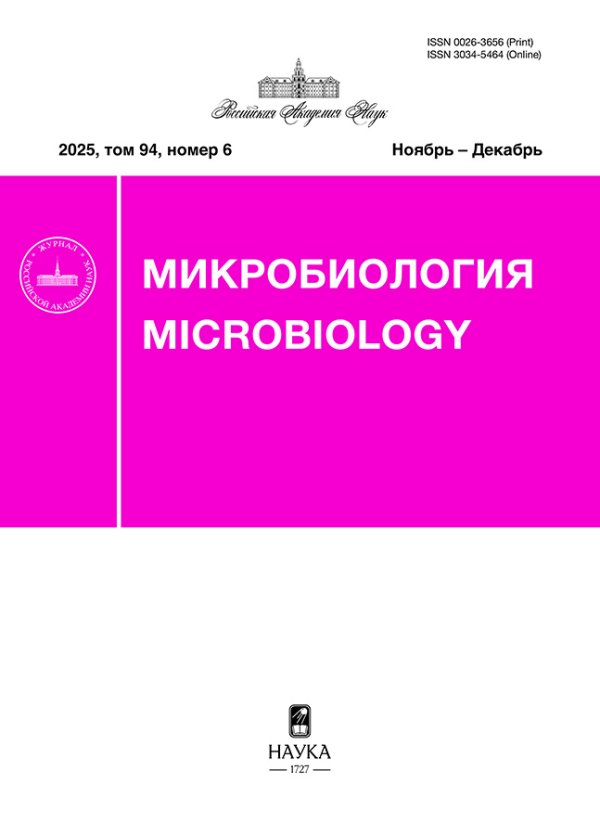Osmolytes and Lipids of the Conidia of the Xerohalophilic Micromycete Aspergillus penicillioides
- Authors: Danilova O.A.1, Ianutsevich E.A.1, Antropova A.B.2, Tereshina V.M.1
-
Affiliations:
- Winogradsky Institute of Microbiology, Research Center of Biotechnology, Russian Academy of Sciences
- Federal State Scientific Institution “Mechnikov Research Institute for Vaccines and Sera”
- Issue: Vol 92, No 6 (2023)
- Pages: 617-624
- Section: EXPERIMENTAL ARTICLES
- URL: https://journals.rcsi.science/0026-3656/article/view/231914
- DOI: https://doi.org/10.31857/S0026365623600402
- EDN: https://elibrary.ru/BWOGDU
- ID: 231914
Cite item
Full Text
Abstract
Abstract—
Investigation of the lipid and osmolyte composition in conidia of the xerohalophile Aspergillus penicilloides grown on media with high concentrations of NaCl and glycerol is important for the understanding of the functions of these compounds in the adaptation of the extremophile. Conidia of the fungus grown on a medium with glycerol contained up to 15% of the dry mass of carbohydrates and polyols (CaP) of the cytosol, with predominance of glycerol (60% of the total) in their composition, while on a medium with salt, the proportion of glycerol did not exceed 20%, and the amount of CaP was 10%. On both media, the proportion (20%) and amount (2.5%) of trehalose were the same; the proportion of polyols was thus about 80%, although their composition was different, indicating a possible synergy between trehalose and polyols in adaptation. Both variants of conidia were characterized by a low content of both membrane and storage lipids, represented mainly by triacylglycerides. Phosphatidylcholines and sterols were the predominant membrane lipids of the fungal conidia, regardless of the composition of the medium, which indicated high stability and conservatism of the lipid bilayer. The constancy of the composition of membrane and storage lipids and their low content, the high level of CaP, and significant differences in their composition indicate the key role of osmolytes in the adaptation of fungal conidia to various environmental conditions.
Keywords
About the authors
O. A. Danilova
Winogradsky Institute of Microbiology, Research Center of Biotechnology, Russian Academy of Sciences
Author for correspondence.
Email: noitcelfer@mail.ru
Russia, 119071, Moscow
E. A. Ianutsevich
Winogradsky Institute of Microbiology, Research Center of Biotechnology, Russian Academy of Sciences
Email: noitcelfer@mail.ru
Russia, 119071, Moscow
A. B. Antropova
Federal State Scientific Institution “Mechnikov Research Institute for Vaccines and Sera”
Email: noitcelfer@mail.ru
Russia, 105064, Moscow
V. M. Tereshina
Winogradsky Institute of Microbiology, Research Center of Biotechnology, Russian Academy of Sciences
Email: noitcelfer@mail.ru
Russia, 119071, Moscow
References
- Белов А.П., Зинченко Г.А., Ефременко А.А. Изучение путей обмена жирными кислотами между фосфолипидами и триацилглицеринами у термотолерантных дрожжей Candida rugosa // Микробиология. 1990. V. 59. P. 976–981.
- Терешина В.М., Меморская A.C., Кочкина Г.А., Феофилова Е.П. Покоящиеся клетки в цикле развития Blakeslea trispora: отличия в липидном и углеводном составе // Микробиология. 2002. Т. 71. С. 794–800.
- Tereshina V.M., Memorskaia A.S., Kochkina G.A., Feofilova E.P. Dormant cells in the developmental cycle of Blakeslea trispora: distinct patterns of the lipid and carbohydrate composition // Microbiology. 2002. V. 71. P. 684–689. https://doi.org/10.1023/A:1021432007070
- Терёшина В.М. Термоустойчивость у грибов: роль белков теплового шока и трегалозы // Микробиология. 2005. Т. 74. С. 293–304.
- Tereshina V.M. Thermotolerance in fungi: the role of heat shock proteins and trehalose // Microbiology (Moscow). 2005. V. 74. P. 247–257. https://doi.org/10.1007/s11021-005-0059-y
- Феофилова Е.П., Ивашечкин А.А., Алёхин А.И., Сергеева Я.Э. Споры грибов: покой, прорастание, химический состав (обзор) // Прикл. биохимия и микробиология. 2012. V. 48. P. 5–17.
- Feofilova E.P., Ivashechkin A.A., Alekhin A.I., Sergeeva Y.E. Fungal spores: dormancy, germination, chemical composition, and role in biotechnology (review) // Appl. Biochem. Microbiol. 2012. V. 48. P. 1–11. https://doi.org/10.1134/S0003683812010048
- Argüelles J.-C., Guirao-Abad J.P., Sánchez-Fresneda R. Trehalose: A crucial molecule in the physiology of fungi // Reference module in life sciences. Elsevier, 2017. P. 1–9. https://doi.org/10.1016/B978-0-12-809633-8.12084-9
- Barrera C.R. Formation and germination of fungal arthroconidia // Crit. Rev. Microbiol. 1986. V. 12. P. 271–292. https://doi.org/10.3109/10408418509104431
- Crowe J.H. Trehalose as a “chemical chaperone”: fact and fantasy // Adv. Exp. Med. Biol. 2007. V. 594. P. 143–158. https://doi.org/10.1007/978-0-387-39975-1_13
- Danilova O.A., Ianutsevich E.A., Bondarenko S.A., Antropova A.B., Tereshina V.M. Membrane lipids and osmolytes composition of xerohalophilic fungus Aspergillus penicillioides during growth on high NaCl and glycerol Media // Microbiology (Moscow). 2022. V. 91. P. 503–513. https://doi.org/10.1134/S0026261722601373
- Elbein A.D., Pan Y.T., Pastuszak I., Carroll D. New insights on trehalose: a multifunctional molecule // Glycobiology. 2003. V. 13. P. 17R‒27R. https://doi.org/10.1093/glycob/cwg047
- Glatz A., Pilbat A., Németh G.L., Vince-Kontár K., Jósvay K., Hunya Á., Udvardy A., Gombos I., Péter M., Balogh G., Horváth I., Vígh L., Török Z. Involvement of small heat shock proteins, trehalose, and lipids in the thermal stress management in Schizosaccharomyces pombe // Cell Stress Chaperones. 2016. V. 21. P. 327–338. https://doi.org/10.1007/s12192-015-0662-4
- Hazel J.R. Thermal adaptation in biological membranes: is homeoviscous adaptation the explanation? // Annu. Rev. Physiol. 1995. V. 57. P. 19–42. https://doi.org/10.1146/annurev.ph.57.030195.000315
- Ianutsevich E.A., Danilova O.A., Groza N.V., Kotlova E.R., Tereshina V.M. Heat shock response of thermophilic fungi: membrane lipids and soluble carbohydrates under elevated temperatures // Microbiology (SGM). 2016. V. 162. P. 989–999. https://doi.org/10.1099/mic.0.000279
- Ianutsevich E.A., Danilova O.A., Antropova A.B., Tereshina V.M. Acquired thermotolerance, membrane lipids and osmolytes profiles of xerohalophilic fungus Aspergillus penicillioides under heat shock // Fungal Biol. 2023. V. 127. P. 909–917. https://doi.org/10.1016/j.funbio.2023.01.002
- Iturriaga G., Suárez R., Nova-Franco B. Trehalose metabolism: from osmoprotection to signaling // Int. J. Mol. Sci. 2009. V. 10. P. 3793–3810. https://doi.org/10.3390/ijms10093793
- Kahraman M., Sevim G., Bor M. The role of proline, glycinebetaine, and trehalose in stress-responsive gene expression // Osmoprotectant-mediated abiotic stress tolerance in plants / Ed. Hossain M. et al. Cham: Springer Int. Publishing, 2019. P. 241–256. https://doi.org/10.1007/978-3-030-27423-8_11
- Kogej T., Stein M., Volkmann M., Gorbushina A.A., Galinski E.A., Gunde-Cimerman N. Osmotic adaptation of the halophilic fungus Hortaea werneckii: role of osmolytes and melanization // Microbiology (SGM). 2007. V. 153. P. 4261–4273. https://doi.org/10.1099/mic.0.2007/010751-0
- Kosar F., Akram N.A., Sadiq M., Al-Qurainy F., Ashraf M. Trehalose: a key organic osmolyte effectively involved in plant abiotic stress tolerance // J. Plant Growth Regul. 2019. V. 38. P. 606–618. https://doi.org/10.1007/s00344-018-9876-x
- Kozlova M.V. Life cycle in a haloalkalitolerant ascomycete Heleococcum alkalinum Bilanenko et Ivanova // Автореф. дисс. … канд. биол. наук. М.: МГУ, 2006. https://doi.org/10.13140/2.1.2702.8800
- Kozlova M.V., Ianutsevich E.A., Danilova O.A., Kamzolkina O.V., Tereshina V.M. Lipids and soluble carbohydrates in the mycelium and ascomata of alkaliphilic fungus Sodiomyces alkalinus // Extremophiles. 2019. V. 23. P. 487–494. https://doi.org/10.1007/s00792-019-01100-z
- Mendoza D. de, Pilon M. Control of membrane lipid homeostasis by lipid-bilayer associated sensors: a mechanism conserved from bacteria to humans // Prog. Lipid Res. 2019. V. 76. P. 100996. https://doi.org/10.1016/j.plipres.2019.100996
- Osherov N., May G.S. The molecular mechanisms of conidial germination // FEMS Microbiol. Lett. 2001. V. 199. P. 153–60. https://doi.org/10.1111/j.1574-6968.2001.tb10667.x
- Patel T.K., Williamson J.D. Mannitol in plants, fungi, and plant–fungal interactions // Trends Plant Sci. 2016. V. 21. P. 486–497. https://doi.org/10.1016/j.tplants.2016.01.006
- Petrova-Nikitina A.D., Antropova A.B., Mokeeva V.L., Chekunova L.N., Bilanenko E.N., Bulgakova T.A., Zheltikova T.M. To the study of biocenotic relationships between house dust mites (Acariformes: Pyroglyphidae) and mould fungi // Acarina. 2005. V. 13. P. 75–84.
- Prista C., Loureiro-Dias M.C., Montiel V., García R., Ramos J. Mechanisms underlying the halotolerant way of Debaryomyces hansenii // FEMS Yeast Res. 2005. V. 5. P. 693–701. https://doi.org/10.1016/j.femsyr.2004.12.009
- Rubio-Texeira M., Zeebroeck G. Van, Thevelein J.M. Trehalose metabolism: enzymatic pathways and physiological functions // The Mycota: A Treatise on the Biology of Fungi with Emphasis on Systems for Fundamental and Applied Research / Ed. Hoffmeister D. Cham: Springer International Publishing, 2016. P. 191–277. https://doi.org/10.1007/978-3-319-27790-5_10
- Siderius M., Wuytswinkel O. Van, Reijenga K.A., Kelders M., Mager W.H. The control of intracellular glycerol in Saccharomyces cerevisiae influences osmotic stress response and resistance to increased temperature // Mol. Microbiol. 2000. V. 36. P. 1381–1390.https://doi.org/10.1046/j.1365-2958.2000.01955.x
- Stevenson A., Hamill P.G., Medina Á., Kminek G., Rummel J.D., Dijksterhuis J., Timson D.J., Magan N., Leong S.L.L., Hallsworth J.E. Glycerol enhances fungal germination at the water-activity limit for life // Environ. Microbiol. 2017. V. 19. P. 947–967. https://doi.org/10.1111/1462-2920.13530
- Sussman A.S., Halvorson H.O. Spores their dormancy and germination. New York: Harper & Row, 1966. 354 p.
- Tapia H., Koshland D.E. Trehalose is a versatile and long-lived chaperone for desiccation tolerance // Curr. Biol. 2014. V. 24. P. 2758–2766.https://doi.org/10.1016/j.cub.2014.10.005
- Wang F., Sethiya P., Hu X., Guo S., Chen Y., Li A., Tan K., Wong K.H. Transcription in fungal conidia before dormancy produces phenotypically variable conidia that maximize survival in different environments // Nat. Microbiol. 2021. V. 6. P. 1066–1081. https://doi.org/10.1038/s41564-021-00922-y
- Yancey P.H. Organic osmolytes as compatible, metabolic and counteracting cytoprotectants in high osmolarity and other stresses // J. Exp. Biol. 2005. V. 208. P. 2819–2830. https://doi.org/10.1242/jeb.01730
- Yu R.K., Koerne, T.A.W., Scarsdale J.N., Prestegard J.H. Elucidation of glycolipid structure by proton nuclear magnetic resonance spectroscopy // Chem. Phys. Lipids. 1986. V. 42. P. 27–48.https://doi.org/10.1016/0009-3084(86)90041-1
- Zajc J., Kogej T., Galinski E.A., Ramos J., Gunde-Cimerman N. Osmoadaptation strategy of the most halophilic fungus, Wallemia ichthyophaga, growing optimally at salinities above 15% NaCl // Appl. Environ. Microbiol. 2014. V. 80. P. 247–256. https://doi.org/10.1128/AEM.02702-13
Supplementary files
















